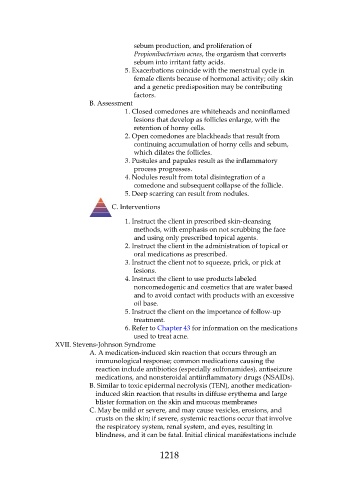Page 1218 - Saunders Comprehensive Review For NCLEX-RN
P. 1218
sebum production, and proliferation of
Propionibacterium acnes, the organism that converts
sebum into irritant fatty acids.
5. Exacerbations coincide with the menstrual cycle in
female clients because of hormonal activity; oily skin
and a genetic predisposition may be contributing
factors.
B. Assessment
1. Closed comedones are whiteheads and noninflamed
lesions that develop as follicles enlarge, with the
retention of horny cells.
2. Open comedones are blackheads that result from
continuing accumulation of horny cells and sebum,
which dilates the follicles.
3. Pustules and papules result as the inflammatory
process progresses.
4. Nodules result from total disintegration of a
comedone and subsequent collapse of the follicle.
5. Deep scarring can result from nodules.
C. Interventions
1. Instruct the client in prescribed skin-cleansing
methods, with emphasis on not scrubbing the face
and using only prescribed topical agents.
2. Instruct the client in the administration of topical or
oral medications as prescribed.
3. Instruct the client not to squeeze, prick, or pick at
lesions.
4. Instruct the client to use products labeled
noncomedogenic and cosmetics that are water based
and to avoid contact with products with an excessive
oil base.
5. Instruct the client on the importance of follow-up
treatment.
6. Refer to Chapter 43 for information on the medications
used to treat acne.
XVII. Stevens-Johnson Syndrome
A. A medication-induced skin reaction that occurs through an
immunological response; common medications causing the
reaction include antibiotics (especially sulfonamides), antiseizure
medications, and nonsteroidal antiinflammatory drugs (NSAIDs).
B. Similar to toxic epidermal necrolysis (TEN), another medication-
induced skin reaction that results in diffuse erythema and large
blister formation on the skin and mucous membranes
C. May be mild or severe, and may cause vesicles, erosions, and
crusts on the skin; if severe, systemic reactions occur that involve
the respiratory system, renal system, and eyes, resulting in
blindness, and it can be fatal. Initial clinical manifestations include
1218

